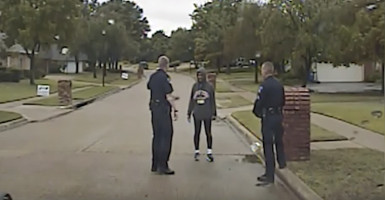If you wonder about the bias and lack of objectivity and accuracy of reporters in the mainstream media, look no farther than what they are learning at schools like the University of North Texas, where Dorothy Bland is the dean of the school of journalism.
Bland recently wrote an article in the Dallas Morning News about her supposed harassment by police officers for “walking while black” that doesn’t bear even a passing resemblance to what really happened.
Of course, we would not know this based on her allegations of racist treatment. But fortunately for us and the Corinth, Texas, Police Department, the officers who encountered Bland turned on the dashcam video in their police cruiser before they stopped her.
Bland is lucky that she wasn’t run over by a car due to her reckless behavior, and that she didn’t get a ticket from the very polite officers who had to deal with her.
Bland’s Faulty Journalism
Bland asserted in her Dallas Morning News commentary that she was stopped while taking a walk in her neighborhood simply because she has “a brown face in an affluent neighborhood.”
She claims the police used their flashing lights and siren to stop her, and she resents the fact that they asked her where she lived and if she had an ID.
She found this highly insulting because, as she told the officers, this was her neighborhood, and “I’m a taxpayer who pays a lot of taxes.” In fact, she completed “the Harvard University Institute for Management and Leadership in Education in 2014” and has hosted lots of gatherings in her home without the police being called.
According to Bland, her “education or property-owner status didn’t matter” to these police officers.
Bland took photos of the officers and posted them on Facebook with her version of event, and “within hours, more than 100 Facebook friends spread the news from New York to California.”
This was “obviously” the result of racial profiling, according to some of her Facebook friends, and Bland was “now in the company of Henry Louis Gates and others with the same experience.”
The Real Story
Too bad Bland didn’t post the dashcam video on her Facebook page so all of her friends could see what really happened, as opposed to the myth she started spreading “from New York to California” almost immediately.
Bland was power-walking, wearing a hoodie and earbuds, and obviously paying no attention to her surroundings. On a street with sidewalks on both sides, she was instead walking in the street, which was her first foolish mistake.
Her second foolish mistake was not walking facing the oncoming traffic, as we have all told our children to do. Instead, she was walking with the traffic coming up behind her, traffic to which she was obviously oblivious and couldn’t hear or see because of her earbuds and hoodie.
As the police cruiser drives slowly behind Bland, she moves from walking on the side of the street to the middle of the street, completely obstructing traffic.
In fact, says Debra Walthall, chief of police in Corinth, Bland’s behavior was brought to their attention when two officers saw a pickup truck come up directly behind Bland, a truck “that had to almost come to a complete stop to avoid hitting her.” According to Walthall, “the driver of the truck looked at the officers as they passed and held his hands in the air, which implied ‘aren’t you going to do something about this?’”
At that point, the officers turned on their dashcam and filmed Bland walking on the side and then in the middle of the road, paying no attention to the traffic coming up behind her. She didn’t even notice the police car until the officers turned on their lights—not the siren, as Bland also mistakenly claimed in her angry commentary about how she was racially profiled.
The video shows two very polite police officers talking to Bland after they stopped her. They advised her that she needed to stay on the side of the road with oncoming traffic, so she could see approaching cars. Bland is angry that she was asked for an ID, but that is standard procedure for all police officers when they make a stop—regardless of the race of the person they are talking to—particularly when the person stopped was observed committing a crime or a traffic violation.
And in this case, Bland, who didn’t have an ID, simply gave the officers her name. Without giving her a ticket for obstructing traffic, which is a misdemeanor, they let her get on with her exercise.
The Problem With Bland’s Account
Bland’s complete overreaction and failure to recognize her own negligent and dangerous behavior are quite striking. As is her immediately jumping to the conclusion that she was profiled because of her race and shouldn’t have been stopped because of her academic background and status.
I live in a small town in Virginia, and I also take walks for exercise. Unlike Bland, I stay on the sidewalks and don’t walk in the street with my hearing and vision obscured. There is no question that if I were walking down the middle of the road like Bland, I would get stopped by one of my town’s police officers. And it wouldn’t be because of my race. In fact, I would be lucky if I didn’t get a ticket for such stupid behavior.
The vanity, arrogance, and conceit that shine through Bland’s commentary are quite revealing. And it says a lot about the field of journalism.
The biased, false assumptions that Bland reflects, that police officers are racists who target minorities and that we have an inherently discriminatory criminal justice system, are being spread by everyone from the Black Lives Matter movement to the president and Justice Department officials.
Bland took a very routine traffic incident where she was at fault and completely twisted it to portray herself as the victim and to fit all of her biased assumptions about law enforcement.
Before becoming the dean of the school of journalism at the University of North Texas, Bland also worked at Florida A&M University as a journalism professor and at USA Today.
How many students taught by Bland have left school imbued with these same biases and false assumptions—biases and false assumptions that are now influencing the news events they cover and the stories they write throughout the media world?






























